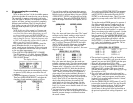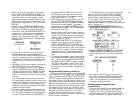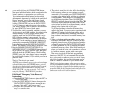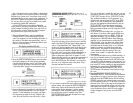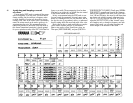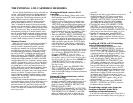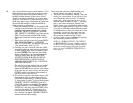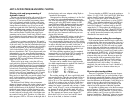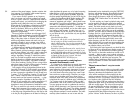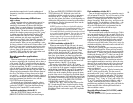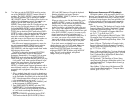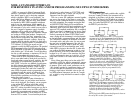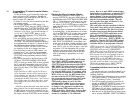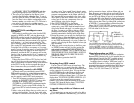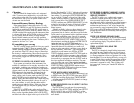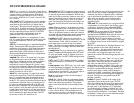variation of the second category. Another variation simi-
lar to category (2) is feedback, which creates frequency
modulation through regeneration.
If you were to set the 6 operators to any frequency
ratios you choose, and set their envelopes and output
levels to "typical" values (i.e., values like those found in
several preset voices), you would find that changing the
algorithm would change the sound very markedly
Notice that the 32 algorithms, as illustrated on the DX7
front panel, are sub-divided into 4 major groups (as
shown by the boxes). While we are about to make a
gross generalization, it can be useful in planning an
approach to programming.
The most complex algorithms are at the upper left (1
through 6). These are examples of straight FM synthesis
with two or three "stacks" of operators per algorithm.
Many of the piano voices or orchestra voices are done
with these algorithms because each stack can be pro-
grammed as though it were a separate voice within a
voice (hence multiple strings on a piano note, or brass,
bell and flute together).
A different type of complex algorithm appears in the
upper right (7 through 18). These are useful for voices
whose harmonic structure undergoes complex changes,
yet with fewer different "sub voices" within a voice (bass,
harp, and stringed instruments, for example). Of this
cateogry algorithms 7 through 15 include two carriers
each, one of which has multiple stacks of modulators
feeding it through two different carrier inputs (good for
electric pianos as an example). Algorithms 16 through
18 also have branching, but they all have a singe carrier
whose three inputs are fed by different stacks of modula-
tors (good for brass sounds, as an example).
Less complex still are the algorithms pictured at the
lower left (19 through 25). Each includes one modulator
which feeds 2 or more carriers, and the number of carri-
ers form a progression: algorithms 19 and 20 each have
3 carriers, 21 to 23 each have 4 carriers, 25 and 26 each
have 5 carriers. These are useful for sounds with more
discrete attacks and less harmonic complexity — a pipe
organ for example. Algorithms in the lower right (26
through 32) are arranged with a similar progression of 3,
4, 5 and 6 carriers, but these are the least complex
algorithms in terms of the amount of modulation availa-
ble. They are useful for such sounds as electric organs,
simple wind instruments like a recorder, and so forth.
When you set out to create a given sound, you'll have
to find the group of algorithms that you feel may be able
to do the job; this judgement can be based on looking at
what algorithms the presets use, or by logical reasoning
(after you learn a little more about programming the
DX7.) Within a given group of algorithms, begin with
the least complex algorithm that you feel will do the job
— that is, the algorithm with the highest number. (We
realize that decision, in itself, requires a reasonable
amount of experience and insight... which should come
more quickly if you follow our guidelines.) You may also
find that it is sometimes possible to get precisely the
same results with different algorithms — it depends on
whether you're using feedback, and on the actual output
level settings of each operator. At other times, two or
more algorithms may at first seem to be the same, and
as you refine the voice, you find that only one algorithm
will do the job.
Algorithm Selection Hints:
Two carriers, side by side, can be functionally equiva-
lent to having two distinct sound sources that are
simply added together. You can also program the two
carriers with nearly the same parameters for a "richer"
or "thicker" texture.
Regardless of the algorithm you select, use the fewest
number of operators you can when you begin to pro-
gram. Turn off the others while programming by using
the [OPERATOR ON-OFF] buttons; if you want them
to remain off alter the voice is stored, turn their
[OPERATOR OUTPUT LEVEL] to zero.
Learn to program by studying how
acoustic Instruments work
It is important to consider how an acoustic instrument
creates sound, and to think about the relationship
between particular "patches" on the DX to the method of
sound generation in the acoustic instrument. For exam-
ple, if you are trying to duplicate the sound of a piano,
you would observe that many piano keys cause a ham-
mer to strike two or three strings. Therefore, you might
want to use an algorithm with two or three carrier/
modulator stacks. Each stack can then be programmed
to duplicate the sound of a different string, emulating the
2 or 3 strings struck by the hammer. There are other
considerations, such as the sound of the hammer itself.
You may program one stack to synthesize the sound of
the felt striking the string(s), and then use the remaining
stack(s) to create the string sound. The shifting harmonic
structure of the acoustic piano note can be simulated by
using different envelopes for each modulator. The inhar-
monicity (where harmonics are not in tune with the
fundamental) can be simulated by using the [DETUNE]
function, and thereby changing the modulator frequen-
cies to be slightly "off" from the perfect integer ratios.
(Even though the frequency might still indicate some-
thing like "2.00", Detune causes it to be more like "2.001
or 1.998".)
If you're working on a bowed or plucked string sound,
you can probably visualize the string being stretched
initially then, as the vibration settles down, the note gets
quieter. The initial stretch not only leads to a louder
sound, it also raises the pitch, which then falls steadily
toward the "normal" pitch of the note as the amplitude
also falls. This effect can be simulated by using the Pitch
Envelope. Set it for a slight increase in pitch initially (L1
slightly higher than 50), and then set the pitch of the
rest of the voice to be "normal" (L2, L3 and L4 at 50). R1
should be at 99 so that the pitch initially starts at the
higher frequency and then R2 can be set to a moderate
rate so the pitch falls to normal at a rate resembling that
of the plucked or bowed string. LFO pitch modulation
can simulate vibrato, and so forth.
By following this logical approach, you should be able
to figure out how to program more complex sounds with
less guessing... or at least with more directed guessing.
This is not to say that other methods are invalid or will
not work — there are many ways to obtain a pleasing
sound. Some piano voices, for example, can be achieved
using Algorithm 19, which has just one carrier. The
multiple stacks of modulators which all affect that carrier
can be programmed to achieve the hammer strike and
string sounds.
There is more than 1 way to create
a pitch
There are many ways to achieve a given pitch within
a particular voice. At first, it may seem that the carrier
frequency determines the fundamental pitch of the
voice, and the modulator(s) affect primarily the har-
monics or overtones. However, you will find this is not
necessarily the case. For example, changing the carrier
to a frequency ratio of 6.00 and the first modulator
above it to a ratio of 2.00 can produce tones that have a
fundamental pitch which is considerably lower than the
6.00 ratio would suggest. This is due to the strength of
the sum and difference products of modulation — the
so-called "sub harmonics" which are produced. When
you are trying to get a particular sound, take the time to
experiment with many different frequency ratios, not
just the "obvious" choice. Moreover, be sure to try differ-
52



